#cooking oil manufacturing plant
Explore tagged Tumblr posts
Text
Mectech Palm Oil Refinery Plant- A Legacy of Innovation and Excellence
Oil processing, often known as refining, is the conversion of crude oil into usable products such as petrol, diesel, kerosene, and other petrochemicals. The refining process consists of multiple essential steps, including separation, conversion, treatment, blending, and other refining processes.

Oil refining is a complicated and energy-intensive process that necessitates advanced equipment and technology. It is an important link in the worldwide energy supply chain, providing fuel for transportation, heating, and electricity generation, as well as raw materials for the petrochemical sector.
Of all the oil refining and processing industries, palm oil refinery is the most important sector as it is a very complex oil and for its production it requires good quality plant.
Palm Oil Refining
Palm oil refining industries are among the world's most important manufacturing sectors, and palm oil has grown to become the world's most traded vegetable oil. Indonesia and Malaysia are the main producers, with exporting enterprises for crude palm oil.
Crude palm oil is derived from palm oil's mesocarp. Extracted Crude Palm oil contains some undesirable contaminants, which must be eliminated partially or fully throughout the palm oil refining process to produce good edible oil with increased stability and keepability.
Palm oil is currently a popular cooking oil in many tropical nations, including South East Asia, Africa, and sections of Brazil. Its popularity is attributed due to its higher heat resistance as compared to any other vegetable oil and also because of its lower cost and good oxidative stability.
Palm's unique and finest quality is that it generates two forms of oil: palm oil and palm kernel oil.
Palm oil is derived from the flesh of the palm fruit, whereas palm kernel oil is extracted from the seeds or kernel of the palm fruit using the palm kernel oil process.
Palm oil is derived from fresh palm fruit flesh through pressing and centrifugation at a palm oil facility. To avoid deterioration of Palm Oil, it must be extracted from fresh palm fruit. As a result, countries that cultivate palm oil remove it to prevent it from deteriorating. The crude palm oil's colour is yellow-red or dark yellow, and its taste is sweet.
The crude palm oil extracted contains undesired contaminants, which hurt the oil's physical appearance, quality, oxidative stability, and shelf life. To eliminate the aforementioned pollutants, the oil is sent to a palm oil refinery plant, where it is refined, bleached, and deodorised. After refining the palm oil, the RBD oil is sent to the fractionation unit to extract palm olein and stearin.
Palm Oil Refinery Plant
Palm oil refining is divided into the sections below:
In most palm oil refining plants, the refining process is a vital stage in the manufacture of edible oils and fats. The finished product's properties that must be monitored include flavour, shelf life, stability, and colour.
Crude vegetable oil can be refined in two ways: physically or chemically. During crude palm oil refining, FFA is removed to obtain a maximum FFA level of 0.1%.
Physical refining typically has a smaller environmental impact than chemical refining.
Bleaching edible oils and fats is an important step in the refining process for crude oils and fat. It does eliminate numerous contaminants, which hurt the physical look and quality of the oil. Generally, the oil is taken to the bleaching section first, and the gums are treated with phosphoric acid so that they may be separated in the pressure leaf filter after bleaching.
During this stage, the adsorptive activity of bleaching earth removes trace metal complexes like iron and copper, colouring pigments, phosphatides, and oxidative products.
This bleached oil is next filtered through industrial filters such as a filter press, a hermetically sealed vertical leaf pressure filter, a plate, or a frame filter.
Mectech's unique bleacher design keeps the bleaching earth in full suspension, resulting in no dead zones and lower utility use. Mectech Bleacher guarantees high-quality oil because the bleaching procedure for crude palm oil is carried out under controlled conditions.
Mectech also excels in supplying facilities for rice bran oil processing refinery in India and abroad. Mectech Rice Bran Oil Extraction Machinery in India and abroad offers the following advantages.
#Oil processing#often known as refining#is the conversion of crude oil into usable products such as petrol#diesel#kerosene#and other petrochemicals. The refining process consists of multiple essential steps#including separation#conversion#treatment#blending#and other refining processes.#Oil refining is a complicated and energy-intensive process that necessitates advanced equipment and technology. It is an important link in#providing fuel for transportation#heating#and electricity generation#as well as raw materials for the petrochemical sector.#Of all the oil refining and processing industries#palm oil refinery is the most important sector as it is a very complex oil and for its production it requires good quality plant.#Palm Oil Refining#Palm oil refining industries are among the world's most important manufacturing sectors#and palm oil has grown to become the world's most traded vegetable oil. Indonesia and Malaysia are the main producers#with exporting enterprises for crude palm oil.#Crude palm oil is derived from palm oil's mesocarp. Extracted Crude Palm oil contains some undesirable contaminants#which must be eliminated partially or fully throughout the palm oil refining process to produce good edible oil with increased stability an#Palm oil is currently a popular cooking oil in many tropical nations#including South East Asia#Africa#and sections of Brazil. Its popularity is attributed due to its higher heat resistance as compared to any other vegetable oil and also beca#Palm's unique and finest quality is that it generates two forms of oil: palm oil and palm kernel oil.#Palm oil is derived from the flesh of the palm fruit
0 notes
Text
જાણો 6 ટન ઓટોમેટિક પ્લાન્ટ માં કેટલી મશીનરી આવે છે? તમે હકીકતમાં કેટલો નફો મેળવી શકો,અને તેલ ક્યાં વેચી શકાય છે?
હેલો મિત્રો નમસ્કાર આજે આપણે જાણીશુ 6 ટન ઓટોમેટિક પ્લાન્ટ કેવી રીતે કામ કરે છે અને તેમા કઈ કઈ મશિનરીનો ઉપયોગ થાય છે? અમે તમને જણાવીશું કે તેમાં કેટલી મશીનરી આવે છે અને વિડિઓમાંતો બધા કહેશે આટલો નફો મળે ને તેટલો નફો મળે પણ હકીકતમાં કેટલો નફો મળે છે? મિત્રો, વિનંતી છે કે આ પોસ્ટને અંત સુધી વાંચજો અને જો તમને ગમે તો લાઈક અને શેર કરવાનું ભૂલતા નહીં. તો ચાલો જોઈએ કે મગફળીના તેલ ઉત્પાદનનો…
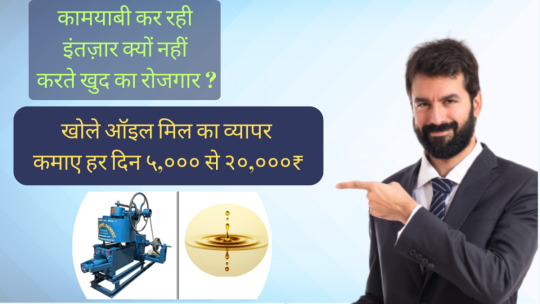
View On WordPress
#6 ton oil mill plant#Automatic Oil Mill#automatic oil mill plant#Cooking Oil Manufacturing#Edible Oil Production#fully automatic groundnut oil mill plant#groundnut oil mill plant project report#how to start groundnut oil manufacturing plant?#Oil Extraction#Oil Extraction Machine#oil mill business#Oil Press Machine
0 notes
Text
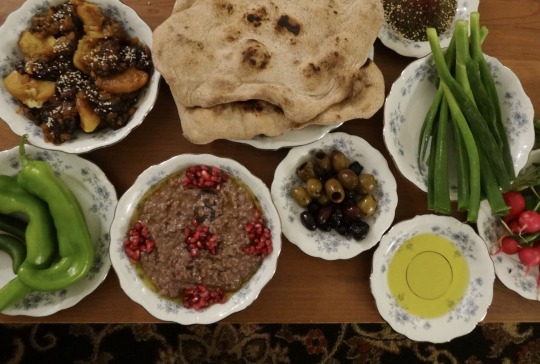

[ID: A purplish-grey stew topped with olive oil and garnished with piles of pomegranate seeds. Plates of green peppers, bitter olives, olive oil, taboon bread, green onions, radishes, and za'tar surround the dish. The second image is a close-up of the same stew. End ID]
رمانية / Rummāniyya (Palestinian pomegranate stew)
Rummaniyya (رُمَّانِيَّة; also transliterated "rumaniyya," "rummaniya," and "rummaniyeh") is a Palestinian stew or dip made from lentils, eggplant, and pomegranate seeds, flavored with nutty red tahina and a zesty, spicy دُقَّة (dugga) of dill seeds, garlic, and peppers. A طشة (ṭsha), or tempering, of olive oil and onion or garlic is sometimes added.
"Rummaniyya," roughly "pomegranate-y," comes from رُمَّان ("rummān") "pomegranate," plus the abstract noun suffix ـِيَّة ("iyya"); the dish is also known as حبّة رُمَّانَة ("ḥabbat rommāna"), or "pomegranate seeds." It is a seasonal dish that is made at the end of summer and the beginning of fall, when pomegranates are still green, unripe, and sour.
This stew is considered to be one of the most iconic, historic, and beloved of Palestinian dishes by people from Gaza, Yaffa, and Al-Ludd. Pomegranates—their seeds, their juice, and a thick syrup made from reducing the juice down—are integral to Palestinian cuisine and heritage, and images of them abound on ceramics and textiles. Pomegranates and their juice are sold from street carts and cafes in the West Bank and Gaza.
Today, tens of thousands of tons of pomegranates are grown and harvested by Israeli farmers on stolen Palestinian farmland; about half of the crop is exported, mainly to Europe. Meanwhile, Palestinians have a far easier time gaining permits to work on Israeli-owned farms than getting permission from the military to work land that is ostensibly theirs. These restrictions apply within several kilometers of Israel's claimed borders with Gaza and the West Bank, some of the most fertile land in the area; Palestinian farmers working in this zone risk being injured or killed by military fire.
Israel further restricts Palestinians' ability to work their farms and export crops by imposing tariffs, unexpectedly closing borders, shutting down and contaminating water supplies, spraying Palestinian crops with pesticides, bulldozing crops (including eggplant) when they are ready to be harvested, and bombing Palestinian farmland and generators. Though Palestinian goods have local markets, the sale of Palestinian crops to Israel was forbidden from 2007 to 2014 (when Israel accepted shipments of goods including tomato and eggplant).
Gazans have resisted these methods by disregarding orders to avoid the arable land near Israel's claimed borders, continuing to forage native plants, growing new spices and herbs for export, planting hydroponic rooftop gardens, crushing chalk and dried eggplants to produce calcium for plants, using fish excrement as fertilizer, creating water purification systems, and growing plants in saltwater. Resisting Israeli targeting of Palestinian food self-sufficiency has been necessary for practical and economic reasons, but also symbolizes the endurance of Palestinian culture, history, and identity.
Support Palestinian resistance by calling Elbit System's (Israel's primary weapons manufacturer) landlord; donating to Palestine Action's bail fund; and buying an e-Sim for distribution in Gaza.
Serves 6-8.
Ingredients:
For the stew:
1 medium eggplant (370g)
1 cup brown lentils (عدس اسود)
600g pomegranate seeds (to make 3 cups juice)
3 Tbsp all-purpose flour
1/4 cup red tahina
1/2 cup olive oil
Salt, to taste
Citric acid (ملح الليمون / حامِض ليمون) (optional)
Red tahina may be approximated with home cooking tools with the above-linked recipe; you may also toast white tahina in a skillet with a little olive oil, stirring often, until it becomes deeply golden brown.
For the دُقَّة (dugga / crushed condiment):
2 tsp cumin seeds, or ground cumin
1 1/2 Tbsp dill seeds ("locust eye" بذور الشبت / عين جرادة)
5 cloves garlic
1 green sweet pepper (فلفل بارد اخضر)
2 dried red chilis (فلفل شطة احمر)
People use red and green sweet and chili peppers in whatever combination they have on hand for this recipe; e.g. red and green chilis, just green chilis, just red chilis, or just green sweet peppers. Green sweet peppers and red chilis are the most common combination.
For the طشة (Tsha / tempering) (optional):
Olive oil
1 Tbsp minced garlic
Instructions:
1. Rinse and pick over lentils. In a large pot, simmer lentils, covered, in enough water to cover for about 8 minutes, or until half-tender.
2. Meanwhile, make the dugga by combining all ingredients in a mortar and pestle or food processor, and grinding until a coarse mixture forms.
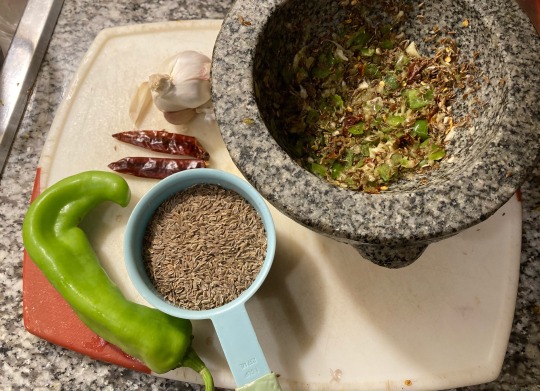
Dugga and components.
3. Cube eggplant. A medium-sized eggplant may be cut in half lengthwise (through the root), each half cut into thirds lengthwise, then cubed widthwise.
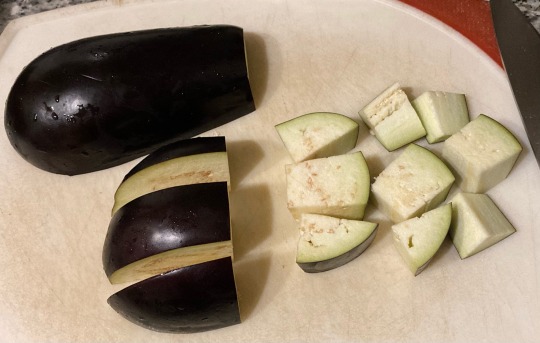
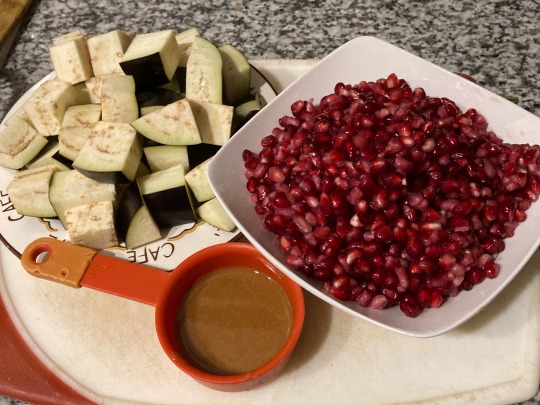
Cubed eggplant, red tahina, and pomegranate seeds.
4. Add eggplant to simmering water (there is no need to stir).
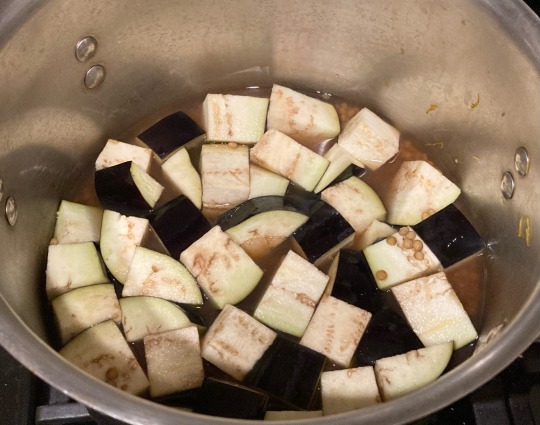
5. While the eggplant cooks, blend pomegranate seeds in a blender very thoroughly. Strain to remove any gritty residue. Whisk flour into pomegranate juice.
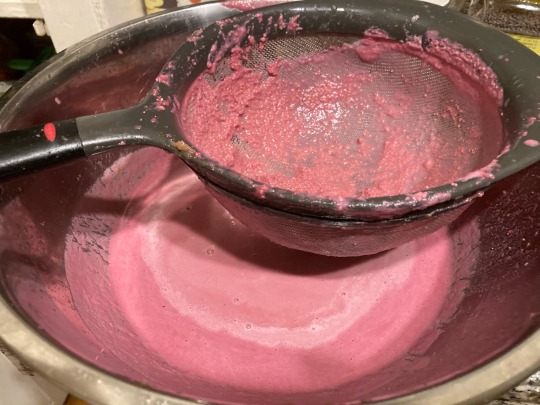
Pomegranate juice being strained.
6. Taste your pomegranate juice. If it is not sour, add a pinch of citric acid or a splash of lemon juice and stir.
7. Add dagga to the pot with the lentils and eggplant and stir. Continue to simmer until the eggplant is very tender and falling apart.
8. Add pomegranate juice, tahina, and olive oil to the pot, and simmer for another 5 minutes, or until stew is very thick and homogenous.

Bright pink pomegranate juice in stockpot.
9. (Optional) In a small skillet, heat a little olive oil on medium. Fry minced garlic, stirring constantly, until golden brown. Add into the pot and stir.
10. (Optional) Mash the stew with the bowl of a ladle or a bean masher to produce a more homogenous texture.
Serve rummaniyya hot or cold in individual serving bowls. It may be served as an appetizer, or as a main dish alongside flatbread, olives, and fresh vegetables such as radishes, green peppers, green onions, carrots, and romaine lettuce. It may be eaten with a spoon, or by using كماج (kmāj), a flatbread with an internal pocket, to scoop up each bite.
571 notes
·
View notes
Text
Brief check in re: Helene. TLDR I’m alive but my world has been upended and I’ll be off this website for awhile, even if I wanted to we barely have communications in our flood ravaged city. Don’t read this if you have any sort of disaster trauma I guess, I probably should’ve kept this shorter but it kind of got away from me. I may delete/edit later but I don’t really have the capacity for self censorship At the moment, i guess it was good for me to get some of it out stream of consciousness style? Lol idk guess I’m just using my blog as a blog. Anyways I lived bitch
Hi guys, thanks to the couple people who messaged me checking if I was ok, I don’t really have capacity or time to reply to them all, but I’m doing ok all things considered. Basically I live in Western North Carolina and our city has been utterly shattered by flooding after Hurricane Helene. We made it safely to Durham but we are going back tonight with a car full of mutual aid supplies like childrens medicine and chainsaw fuel and cooking oil. I don’t really have the words to describe what I’ve been going through, being cut off from all communications and information for days and have no way to reach your loved ones, to walk through a friend’s house to try to reach their water and food stash and look up at the tree in the ceiling, to stand on a railroad bridge and look down at an entire neighborhood swept away, to know that your family back home hasn’t heard from you in four days and has no way to know if you’re dead. Five people with one degree of separation to me drowned in flash floods, including two children. A college friend had his entire home swept down the river. It’s just all so uncertain. I cry at nothing. Wandering around unscathed Durham and watching people mow their lawns and go to brunch has been a surreal dream and I can’t believe I am going back. But we got some clean underwear, our first shower, and I even got my favorite taqueria order, a torta de lengua and Jesus Christ you can’t imagine how good that tasted
We’ve been without power for 10 days and the water is likely to be out for weeks, the groundwater people are using to drink and bathe may be contaminated by chemicals from manufacturing plants and you just have no way of knowing, and because the city’s water and septic systems were obliterated there is going to be untold amounts of human waste and waste-borne diseases threatening public health, we just don’t know yet. My brain and body have been wracked by it all, there are times when I am somewhere safe and feel mentally calm but note with this weird sense of detachment that my body is trembling. It’s just indescribable to have your city be unrecognizable and underwater, I’m really shaken. Before we got some texting capacity back, if your roommate just failed to come home one night, you had no way to know that she wasn’t killed out there. We will be without drinking water for weeks when all this is over but that’s peanuts compared to the cars you pass by with the search and rescue symbol for “we found a body here” painted on them.
All of which is just to say I’m alive but things are still very bad and I’ll be without reliable communication for the foreseeable future, not to mention no water, and so obviously I’ll be off here awhile. I’ll be back soon enough complaining about mundane inconveniences but frankly it’s difficult to even talk to anyone outside of Helene’s destruction, I’m going to be reeling for a long time. Don’t reblog this because I won’t have the capacity to monitor this post but I guess donate to the Asheville Survival Project if you have the inclination, that’s a way for people like me who are relatively unscathed to get direct needs like formula, insulin, underwear, and shelf stable goods directly into people’s hands who fared worse, without jumping through the impossible hoops of things like FEMA. But I’ll probably be stepping back from mutual aid stuff to support my best friend who is now responsible for arranging the burials of a family of four, including his friend/coworker and her two boys, whose upcoming wedding he was going to will now be their combined funeral date. It’s really insane out here and leaving the stability of Durham with its electricity, grocery stores, toilets, and internet is honestly a bit devastating. But weirdly it will also be a relief to be back in a place where the grimness in your heart is not at odds with your surroundings and you talk to people without preface, with dirty hair and dirty clothes and break down in tears in any given conversation with a stranger, if that makes sense? I also can’t really imagine evacuating cause that’d be incredibly jarring in a different way. It’s so hard to explain. I’m so irritable and angry and numb all the time. I’m yelling at the person who loves me most in the world, so many of the emotional issues I had before this exploded to a boiling point in shocking and unpredictable ways. I go around floating in a daze.
But I’m very, very lucky to be alive and none of my loved ones killed, I just don’t really know what the next few weeks will hold and if, like, cholera is gonna break out, or people I know will die of things like food allergies because they can’t get a new epipen. There’s absolutely no way to convey what this survivor’s guilt is like, of having survived through sheer random luck of the draw. And the things I have seen with my own eyes will never leave me, and the gruesome phone calls I sat with my friend as he received, with the trauma unfolding in waves as the family’s bodies were identified one by one, and all the graphic details we absorbed of the eyewitness account of their panicked attempts to escape the floodwaters before they were swept to TN. I did not witness it but I cannot shake it. I can’t go more than a few minutes before the phrases ring through my head again. And I work at a school and I have no way of finding out if all my students survived, because they are children without their own contact info, until the school is able to contact me with any deaths. That uncertainty is weighing tremendously on my shoulders right now and I can’t believe I’m sitting in a cafe and I still don’t know the extent of the death toll or if the kids I’ve known and worked with every day for so long we’re able to escape their homes.
I guess just keep Western NC in your thoughts, the devastation is going to take years to crawl back from, but also keep paying attention to Gaza, the trauma and devastation there is so much more unimaginable and this has given me a new perspective on what it’s like to watch from afar as people continue their lives while yours is unrecognizable. Idk how much longer I’m gonna have the capacity for mutual aid stuff here but I’m going to try. I may yet decide to evac, but you must understand this is my home and my community, and I want to be here to support my closest friend through this unimaginable loss, and the fact that he is responsible for arranging all four of their burials. Unless the city orders non essential personnel to leave then I will probably stay.
And there are of course moments of levity and fun, especially before we found out about the people, like breaking into a NC state extension agricultural experiment field and stealing some veggies off the vine, or cooking up big giant feasts of whatever we could save from the fridge.
I’ll check back in when I can and if any of you guys also live in southern Appalachia and need to be put in touch with aid I’ll check my DMs here when I can, we can get people out to you with whatever you need. But yeah just keep us in your thoughts I guess, things are still really bad. I’m going back to shop for more mutual aid stuff but then we’re leaving again but I’ll check in when the internet’s back I suppose
Eat a nice hot meal for me, don’t take ice cubes or your shower for granted, and watch something pretentious. xoxoxoxoxox ur favorite natural disaster survivor, tomato lover sixty nine
26 notes
·
View notes
Text
Turbine Blades Have Piled Up in Landfills. A Solution May Be Coming. (New York Times)

Excerpt from this New York Times story:
The blades on the newest wind turbines sweep an area longer than a football field and are nearly impossible to recycle.
At the end of their life span of around 20 years, they are chopped into pieces and buried in a handful of landfills across the Great Plains. Those few sites in Wyoming, Iowa and South Dakota have a spooky nickname: wind turbine graveyards.
But this waste problem from a growing source of low carbon energy could become a headache of the past.
Researchers at the National Renewable Energy Laboratory have developed what they say is a turbine blade made from plant material that can be recycled. The new substance is made from inedible sugar extracted from wood, plant remains, used cooking oil and agricultural waste.
They say the prototype they developed can perform as well as traditional blades that are made from a combination of fiberglass and plastic and which have been very difficult to reuse.
The new, recyclable material could be easily adopted by industry, said Robynne Murray, one of the researchers at the national laboratory.
Because the blades for wind turbines are shaped in large molds, which can take up entire warehouses and are expensive to build, it is critical for any new material to be compatible with existing molds and production facilities. And the substance developed by the national laboratory does exactly that, Dr. Murray said.
It’s “designed to be a drop-in replacement,” she said. “Manufacturers should be able to just take it and use it.”
Blades made from the new materials could be 3 to 8 percent more expensive than traditional blades, according to one estimate.
16 notes
·
View notes
Note
Do you have any specific tips on learning to keep kosher? Advice like what dairy substitutes work best or a reliable place to get recipes would be great. I grew up in a house that mixes dairy and meat for most meals so any help would be greatly appreciated. If you've already answered this, could you give a link to the post? I couldn't find one, but that might be because tumblr's search function doesn't work.
Sure! Here is a post I made about keeping kosher. Substitutes are your best friend. If a recipe calls for butter, using vegetable oil instead could be better if you're eating it with a meat meal. Margarine is also a great substitute when making baked goods. Mixing lemon juice with a nut milk gives you buttermilk.
In brownies, using orange juice instead of milk makes the flavor really pop. I love doing this on shabbat so I can have a dessert after a meat meal. You could also just use any other nut milk, or oat milk (just make sure it has a pareve symbol on it, I've seen some oat milks that are still OU D because it's sometimes manufactured in dairy machines or factories). Pareve chocolate is a miracle to be appreciated. Using egg noodles or zucchini noodles are great when you want to have a meat-based dish, and pareve bread for meat-based sandwiches.
I love using vegan or vegetarian plant-based meats in my dishes.* For example, I use vegan ground beef in my lasagna, so I can still use regular noodles and cheese. Plant-based chicken is also great for skillets or pasta. You could also just use fish instead, as it's considered pareve. I don't like the taste of vegan cheese, so I'd much rather use real cheese and vegan meat, but it's always an option. If you don't have meat but still want a filling meal, using grains such as quinoa, or starches like potatoes, can help with that.
As for finding recipes, there are a few kosher cooking blogs online. To find things I usually just search whatever food I want followed by "kosher" and it's usually there. If I can't find a recipe for it, I use a regular recipe with the above substitutes to make it kosher. Buying kosher cookbooks is also a good idea. I don't recommend just searching for "jewish cookbooks" because sometimes those include non-kosher dishes, so search specifically for kosher cookbooks.
*Some Jews have customs that don't allow them to eat vegan meats due to abiding by the spirit of the law, and the fact that the appearance of eating something not kosher could mislead others. It is best to discuss this with your rabbi if you think this may be an issue.
58 notes
·
View notes
Text

Feeding Soul, Freeing Soil
“...all of us will come back again to hoe in the ground... Or hand-adze a beam, or skin a pole, or scrape a hive — we’re never going to get away from that We’ve been living a dream that we’re going to get away from that. Put that out of our minds... That work is always going to be there.” — Gary Snyder, in The Real Work: Interviews and Talks, 1964–1979
In the pre-industrial world, food was the basis of human life. If not deserving of outright ceremonial worship, then certainty food was not something just taken for granted. Sure, this was probably out of pure necessity of survival, and due to technologies in our culture we have more of a margin of error. But I have to wonder when I consider the mindlessness with which so many of us purchase, prepare, consume, and dispose of food, if the “privileges” of convenience and effortlessness are really worth the consequences. On psychological and spiritual levels, the disconnect between our daily lives and the source of our very existence — the raw material that fuels our bodies and minds — has an effect that is both profoundly symbolic, and frighteningly real.
Most of us would agree that food is a catalyst for family and community bonds. Without it, the very fabric of our cultures comes unraveled And we can see that happening today. We have no time to cook, and even less time to eat. Our culture’s fixation on efficiency and timesaving makes it impossible for us to appreciate what goes into producing it. In our ignorance, we demand produce that is not seasonal or bioregional, the transportation of which fills 4 million trucks a year, which use $5.5 billion worth of fuel, and spew 4 million tons of pollutants into the air. The average distance food travels from farm to fork is 1300 miles! (Rodale, 1981) We demand certain tastes at a snap of the fingers, even if it means transporting a spice thousands of miles, or using large amounts of oils pressed from genetically engineered seeds half a world away. We demand to be able to cook rice in ten minutes, which requires industrial processing that removes all the nutrients from the grain. Most meat-eaters in modern society don’t ever see the animal until it ends up packaged and in the grocery store. All these “conveniences” reinforce a dangerous sense of detachment and alienation.
One of the most revealing metaphors relating to modern society’s culinary dysfunction is in our dependence on processed foods. People would be more whole eating whole foods, not fragmented and refined commodities with isolated nutrients added back in. Food in its natural state evolved alongside human beings, and when obtained directly, it provides us with all we need. Food processing is an unnecessary obstacle to nutrition that benefits the long line of manufacturers, packagers and advertizers who take 90% of every food dollar, mediating our physical sustenance.
Lack of vitality is a major component of malnutrition from modern food sources. Grown in depleted soils with chemical fertilizers to mimic fertility, the plants become dependent on the chemicals to survive. Similarly, when we eat a lifetime of nutrient- depleted food our bodies become dependent on pharmaceuticals. Just like in the forest, agricultural soil health can be seen as an indicator of the health of the entire system, of which we are a part. If the soil is depleted of nutrients, so is the food that grows in it, and so are those who eat it.
#food sovereignty#gardening#small farms#solarpunk#small farm movement#community building#practical anarchy#practical anarchism#anarchist society#practical#revolution#anarchism#daily posts#communism#anti capitalist#anti capitalism#late stage capitalism#organization#grassroots#grass roots#anarchists#libraries#leftism#social issues#economy#economics#climate change#climate crisis#climate#ecology
8 notes
·
View notes
Text
Food Distribution on Relan
Since @thetruearchmagos seemed interested, thought I would do this haha.
Info and Worldbuilding under the cut
I'm just gonna go over Ferusian food distribution, as it's the leading nation for food practices, and most other nations emulate (to varying degrees of success) these practices.
I may also go slightly off topic, though still relevant, so bear with me.
Ferusian Food Distribution
Ferus is the leading nation for food distribution practices. There are very, very strict laws in place that severely punish poor practice.
Ultimately, this is how food is managed in Ferus:
Food is produced by farms, hunters, and reserves.
Farms specifically deal in crops. Fruits, vegetables, berries, and other plant-based food sources. While some are specialized (the third largest farm in Ferus is 22,000 acres and is dedicated entirely to the growth of corn), others grow a variety of crops (the largest farm in Ferus is approximately 45,000 acres and the land is divided between apple and pear orchards, as well as potato, carrot, and onion fields) for the nation. These farms supply Distribution Firms with the crops, which are then delivered via specially designed trucks to local markets, manufacturing plants, and other such places to be sold or refined.
Some of these trucks are designed for long-distance travel and, through the Speedway that stretches across Ferus, deliver their cargo across the nation to other Distribution Firms, which then deliver the goods to the nearby businesses and markets.
Then there are hunters. In Ferus, "Hunter" is still very much a viable career path. Hunters are employed by the Ferusian Wildlife Management Force (FWMF), and are tasked with preventing overpopulation of invasive species. The FWMF specializes in a practice known as "controlled invasion", wherein they will introduce a small number of a species into an environment where their unique evolutions make them hyper-suited to thrive. This creates an invasive species "problem", and when numbers reach problematic levels, the FWMF deploys waves of Hunters to thin the herd. This manufactured cycle allows Ferus' wildlife to thrive freely in environments suited to them, without allowing any one species to completely dominate all others in an ecosystem.
It also allows the Hunters to hunt year-round, though with a monthly limit on each species.
Species hunted under the authority of the FWMF include, but are not limited to: deer, elk, boar, greatwolves, rabbits, moose, pheasant, duck, and bear.
The last branch of Ferusian food distribution is known as the Reserves.
Reserves are animal farms. Great swathes of land with a safe, peaceful environment where herd animals are raised. Reserves follow strict environmental policies, limiting the size of herds as well as the rate of growth of herds, ensuring the well-being of both local environment and global environment due to how large these Reserves would grow otherwise.
When a herd exceeds the maximum size, Reserve owners enact Culling, a process where they will humanely put down 2/3 of the population of the Reserve. The process for this differs from species to species and from Reserve to Reserve, but strict laws are in place that require methods to be painless and swift, to prevent cruelty.
The 2/3 of the herd that is put down is then delivered to Processing Plants where they are butchered, separated into the various meats and cuts that are available from the species, and prepared for sale and redistribution.
Side note: Due to Tangkorak influence on Ferusian law in the early days, there is a law that forbids waste of a slaughtered animal, and as such every aspect of the animal is used. Bones are used for broth manufacturing, excess fat is turned into cooking oils, and so on. Ferusian Law dictates no part of a slaughtered animal is to go to waste.
This is the first step in Ferusian food distribution.
Once food has been delivered to local businesses and Processing Plants, it goes through the next phase.
Those foods delivered as-is to businesses are simply sold and used by the populace (though locally-grown and locally-raised goods are always free, you only pay for food that was shipped from other parts of the country or other nations).
The food delivered to Processing Plants however is then processed into various forms. Crops are separated into slices, sauces, mashes, jams, jellies, juices, seeds, etc, and packaged as such. Meats are sliced, mashed, blended, shredded, etc, and packaged as such.
These processed forms of food are then distributed locally and across the nation.
It's worth noting that 60% of raw-form food (un-processed meat and crops) are distributed locally, with 60% of processed food also being distributed locally.
Due to the vast farms and reserves that produce food as well as the carefully maintained manufactured ecosystems by the FWMF, food is plentiful in Ferus and any excess is sold to other nations to avoid a hunger crisis and as efforts of good faith and peace between countries.
Note: If there is a specific question any part of this raises, by all means ask. I more than likely have an answer for it.
11 notes
·
View notes
Text
What Is Hemp?
It’s A Trillion Dollar Cash Crop.
youtube
Hemp is a name given to a strain of the cannabis plant.
Hemp is a name given to cultivars of the cannabis plant (Cannabis sativa) that have been selected over many generations for fiber and seed production. Most hemp cultivars contain less than 1.5% THC, a narcotic compound that has the potential for abuse in high concentrations. Cannabis sativa cultivars selected and developed for their drug properties, referred to as marijuana, or dagga, can have a THC content of 3%-25%. Hemp is a bast fiber, producing its fibers in the stalk similar to flax, kenaf, and sun hemp.
Multiple Uses
Hemp fiber and seed are used to produce a wide range of commodities including food and beverage products, fiberboard, insulation, paper, composites, textiles, carpets, animal bedding and feed, cosmetics, body-care products, soaps, paints, fuels, and medicines.
Hemp Seed Food and Beverage Products
Hemp seed contains about 25% protein, 30% carbohydrates, & 15% insoluble fiber. Hemp seed is reported to contain more easily digestible protein than soybeans. Hemp seed contains all 8 amino acids essential to human nutrition. Hemp seed is high in calcium, magnesium, phosphorus, potassium, carotene, sulfur, iron and zinc, as well as Vitamins A, E, C, B1, B2, B3, and B6.
Hemp seed imported into the United States or Canada must be steam sterilized at between 180 degrees F and 212 degrees F for 15 minutes to prevent sprouting. Many US facilities receive imported viable seed under customs bond, steam it, and release it to the consignee or customer with a Certificate of Sterilization.
Hemp food and beverage products include hemp oil and seed, flour, pasta, cheese, tofu, salad dressings, snacks, sweets, hemp protein powders, soft drinks, beer, and wine. Hemp beer can be made from the seed, flowers, sprouts, and seed cake that is a by-product of oil pressing. Hemp beer is produced and sold in Europe and the United States of America.
Hemp Oil
Hemp seed is 25% to 35% oil, and is one of the oils lowest in saturated fats (8%). Hemp seed oil is the richest source of polyunsaturated essential fatty acids (80%). Hemp seed oil is the only common edible seed oil containing Omega-6 Gamma-Linolenic Acid. Hemp seed oil is very fragile and not suitable for cooking.
Pressed hemp seed oil must be bottled immediately under oxygen-free conditions, and must be refrigerated in dark, airtight containers.
Fiberboard
Hemp fiberboard tested by Washington State University Wood Materials and Engineering Laboratory proved to be two and one half times stronger than wood MDF composites, and the hemp composite boards were three times more elastic.
Hemp herds can be used in existing mills without major changes in equipment. Russia, Poland and other Eastern European countries already manufacture composite boards from hemp and other plant materials.
Pulp and Paper
The major use of hemp fiber in Europe is in the production of specialty papers such as cigarette paper, archival paper, tea bags, and currency paper. The average bast fiber pulp and paper mill produces 5,000 tons of paper per year. Most mills process long bast fiber strands, which arrive as bales of cleaned ribbon from per-processing plants located near the cultivation areas.
Composites
Until the 1930’s, hemp-based cellophane, celluloid and other products were common, and Henry Ford used hemp to make car doors and fenders. Today hemp herds can be used to make new plastic and injection-molded products or blended into recycled plastic products. Hemp fibers are introduced into plastics to make them stiffer, stronger and more impact resistant. Hemp plastics can be designed that are hard, dense, and heat resistant, and which can be drilled, ground, milled, and planed.
Hemp plastic products currently made include chairs, boxes, percussion instruments, lampshades, bowls, cups, spectacles, jewelry, skateboards, and snowboards.
Hemp Animal Care
Hemp horse bedding and cat litter are produced and sold in Europe. After oil is extracted from the hemp seed, the remaining seed cake is about 25% protein and makes an excellent feed for chicken, cattle, and fish. Chickens fed hemp seed on a regular basis have been found to produce more eggs, without the added hormones used in most poultry plants.
Fuels
Hemp seed oil can be combined with 15% methanol to create a substitute for diesel fuel which burns 70% cleaner than petroleum diesel. Hemp stalks are rich in fiber and cellulose, making them conducive for conversion into ethanol and methanol fuels that have a higher octane than gasoline and produce less carbon monoxide. These biomass fuels are also free from sulfur, and do not require the addition of lead and benzene used to boost octane and improve engine performance in fossil fuels. Ethanol holds condensation, eliminating oxidation and corrosion, and is reported to reduce carbon dioxide emissions by more than 30%.
Hemp has been studied in Ireland as a biomass fuel to generate electricity. Hemp has been reported to yield 1000 gallons of methanol per acre year. Hemp stalk can be converted to a charcoal-like fuel through a thermochemical process called pyrolysis. Henry Ford operated a biomass pyrolitic plant at Iron Mountain, Michigan in the mid-20th.
Paints and Varnishes and Binders
Until the 1930's, most paints were made from hemp seed oil and flax seed oil. Hemp oil makes a durable, long lasting paint that renders wood water-resistant. Hemp herds have the potential to make glues for composite construction products that are non-toxic and superior to binders currently used. With this technology, industry can produce composite products where all components are derived from hemp.
Markets for Hemp Pulp
Some paper manufacturers already have the equipment to process decorticated hemp fiber into paper. The leading European supplier of non-wood pulp, Celesa, currently produces about 10,000 tons per year of pulp from hemp. The use of hemp pulp in blends with recycled fiber of other non-wood fibers is growing. Tests by several European pulp and paper producers suggest that hemp pulp may replace cotton cost effectively in several specialty paper applications.
Potential Markets for Medical Application of Low-THC Hemp Cultivars
Many cannabis medicines have been produced using cannabis cultivars high in THC, and there has been medical research into cannabis that is low in THC and high in CBD. CBD is a cannabinoid that does not have many of the psychoactive effects associated with THC. CBD has been used to treat the following medical conditions: epilepsy, dystonic movement disorders, inflammatory disorders, pain, chronic insomnia, chorea, cerebral palsy, and Tourette's syndrome. According to a July 1998 report by the National Institute of Health, CBD may hold promise for preventing brain damage in strokes, Alzheimer’s disease, Parkinson’s disease and even heart attacks and has been found to prevent brain cell death in an experimental stroke model.
Please share this with your friends.
youtube
#hemp farming#hemp foods#hemp fuel#industrial hemp#hemp plastic#hemp paper#hemp fibers#hemp seeds#hemp prohibition
4 notes
·
View notes
Text
Mustard Oil / Edible Oil Bottle Filling Line
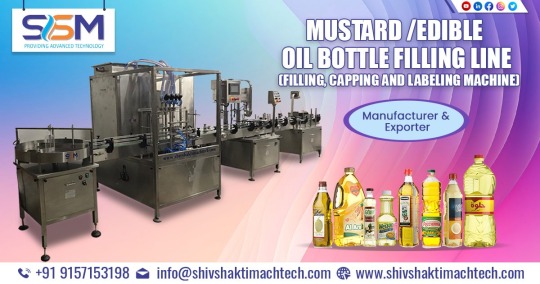
Company Overview: Shiv Shakti Machtech is a Manufacturer, Exporter, and Supplier of Mustard Oil / Edible Oil Bottle Filling Line in Ahmedabad, Gujarat, India. Shiv Shakti Machtech's Mustard Oil Bottle Filling Machine is crafted from top-notch materials, adhering to hygiene standards and facilitating easy cleaning. A Mustard Oil or Edible Oil Bottle Filling Line comprises a series of machines designed for filling, capping, and labeling bottles containing mustard oil or other edible oils. Filling Machine: Equipped to precisely fill bottles with desired quantities of mustard oil or edible oil. Features a conveyor belt system for bottle transportation, precision filling nozzles, and volume adjustment controls. Ensures uniform filling levels and reduces spillage or wastage of oil. Capping Machine: Responsible for securely sealing filled bottles with caps or lids. Utilizes various capping mechanisms (e.g., screw caps, press-on caps, snap-on caps) based on bottle and cap types. Ensures tight and consistent sealing to prevent oil leakage or contamination. Labeling Machine: Applies labels onto filled and capped bottles, providing product information, branding, and regulatory details. Operates with precision and consistency, even at high production speeds. Features may include label applicators, sensors, and controls for accurate label placement and alignment. Application: Food and beverage industry: Used in edible oil processing plants, bottling facilities, and packaging operations for Cooking Oil, Mustard Oil, Soybean Oil, Cottonseed Oil, Vanaspati Ghee, Rice Bran Oil, Sesame Oil, Palm Oil, Mustard Oil, Kachi Ghani Mustard Oil, Refined Oil, Coconut Oil, Sunflower Oil, Corn Oil, Olive Oil, Soya Oil, Canola Oil, Safflower Oil, Oil Spray, Avocado Oil, Rapeseed Oil, Nut Oils, Organic Safflower Oil, Palm Oil, Groundnut Oil, Edible Oil, Vegetable Oil. Geographical Coverage: Shiv Shakti Machtech serves as the Manufacturer and Supplier of Mustard Oil / Edible Oil Bottle Filling Line in Ahmedabad, Gujarat, India, and various locations across the country, including Andhra Pradesh, Arunachal Pradesh, Assam, Bihar, Chandigarh, Chhattisgarh, Dadra and Nagar Haveli and Daman and Diu, Delhi, Goa, Gujarat, Haryana, Himachal Pradesh, Jammu and Kashmir, Jharkhand, Karnataka, Kerala, Ladakh, Madhya Pradesh, Maharashtra, Manipur, Meghalaya, Nagaland, Odisha, Puducherry, Punjab, Rajasthan, Sikkim, Tamil Nadu, Telangana, Tripura, Uttar Pradesh, Uttarakhand, and West Bengal. For further details, interested parties can contact Shiv Shakti Machtech. Read the full article
#Ahmedabad#AndhraPradesh#ArunachalPradesh#Assam#Bihar#Chandigarh#Chhattisgarh#DadraandNagarHaveliandDamanandDiu#Delhi#Exporter#Goa#Gujarat#Haryana#HimachalPradesh#India#JammuandKashmir#Jharkhand#Karnataka#Kerala#Ladakh#MadhyaPradesh#Maharashtra#Manipur#Manufacturer#Meghalaya#MustardOil/EdibleOilBottleFillingLine#MustardOil/EdibleOilBottleFillingLineinGujarat#MustardOil/EdibleOilBottleFillingLineinIndia#Nagaland#Odisha
2 notes
·
View notes
Text
‿‿‿‿sustainable aviation fuel‿‿‿‿

so i'm doing something a bit different this post. i want to talk about ✨sustainable aviation fuel✨, or SAF.
picture this: you're sitting in your window seat, watching fluffy clouds drift by as your plane cruises at 30,000 feet. but instead of worrying about your carbon footprint, you can breathe easy knowing that you're flying with sustainable aviation fuel, a game-changer in the fight against climate change.
so, what exactly is sustainable aviation fuel? in simple terms, it's a cleaner, greener alternative to traditional jet fuel, made from renewable sources like plant oils, agricultural waste, and even recycled cooking grease. unlike fossil fuels, which release harmful greenhouse gases into the atmosphere, SAF produces significantly fewer emissions, helping to mitigate the environmental impact of air travel.
but the benefits don't stop there. by investing in sustainable aviation fuel, airlines can reduce their reliance on finite fossil fuels, minimize their carbon footprint, and contribute to a more sustainable future for aviation. plus, SAF can be seamlessly integrated into existing aircraft and infrastructure, making it a practical and scalable solution for the industry.
one of the most exciting aspects of sustainable aviation fuel is its potential to drive innovation and collaboration across the aviation sector. airlines, manufacturers, government agencies, and environmental organizations are joining forces to develop new technologies, improve production processes, and accelerate the adoption of SAF on a global scale.
as consumers, we also play a crucial role in shaping the future of aviation. by choosing airlines that prioritize sustainability and advocating for policies that support the development and use of sustainable aviation fuel, we can drive positive change and encourage the industry to embrace cleaner, greener practices.
so think about it a little the next time you take a flight. we can all fly while protecting the planet we call home :)
#environment#environmetalists#enviromental#sustainability#sustainable#airplane#plane#flying#earth#climate change#environmentalism#climate action#fossil fuels#climate catastrophe#climate crisis
4 notes
·
View notes
Text
Character Intro: Agathodaemon (Kingdom of Ichor)

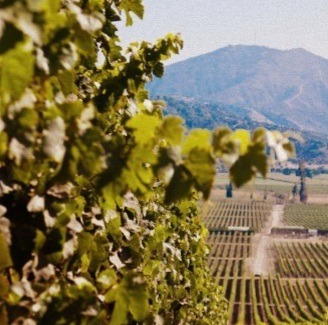
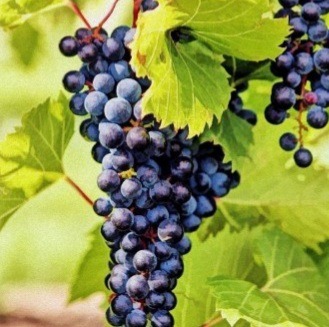



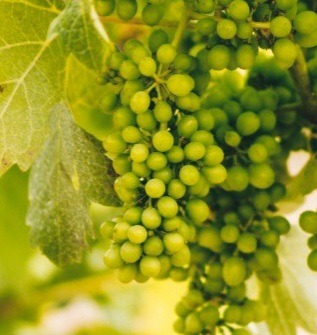

Nicknames- Daemon by the others
Dad by Komos
Age- 47 (immortal)
Location- Crete, Olympius
Personality- He's a true oenophile; someone who loves & appreciates wine in the strict traditions of consumption and reverie. He's also open minded, passionate, and appreciates the finer things in life. He's currently dating.
He has the standard abilities of a god except shapeshifting. As the god of vineyards, grainfields, & luck his other powers/abilities include limited vitakinesis (healing), being able to temporarily grant someone with luck (that lasts 24 hours), limited chlorokinesis (as it pertains to vine plants), having an innate knowledge of agriculture & plants, and limited alcokinesis.
Daemon used to be married to Elais (goddess of oil). They share a child, a son Komos (god of revelry). Even though their divorce was a bit contentious, lately they've been working towards being cordial and establishing a friendship.
He lives by himself in the state of Crete in a breathtaking Mediterraean style mansion just a few miles away from his own vineyard & winery! There's a large rock lined pool and hot tub & inside there are many decorative fruits, paintings, natural stone walls, rattan and cotton furniture pieces, & terracotta pottery pieces. He owns a few horses, a vacation cottage in Santorini, and a yacht called the Carpe Diem. He also travels often to the states of Olympia (to see his girlfriend) & New Olympus (to see his son).
Every morning Daemon rides on horseback to his vineyard to check on the vines.
He's the second largest producer/manufacturer of wine & other alcoholic beverages after Dionysus (god of wine). They have a playful rivalry and friendly rapport with each other, especially since the wild prince was his son's mentor. Daemon's other business is a wine bar/smoking room called Ygró Veloúdo, where the customers can also partake in hookah smoking. With an official website and glowing reviews in The Oracle, Modern Olympus magazine, & Kalí Órexi- the culinary magazine owned by Deipneus (god of cooking & breadmaking), there are plans for other establishments in Santorini, Olympia, the Underworld, as well as the Mania & Skyline neighborhoods of New Olympus.
A go-to thing Daemon likes to make & eat for breakfast is eggs florentine with smoked salmon and garlic home fries, usually topping it off with a glass of champagne. He also likes toasted kalamata olive bagels topped with caviar butter and aloo paratha.
His favorite drink of course is wine. From the rich savory reds of merlot, pinot noir, & shiraz to the crisp fruity whites of chardonnay, pinot gris, & sauvignon blanc, always following the 5 S's of wine tasting- see, swirl, sniff, sip, and savor. He also likes classic martins, bellins, bourbon whiskey, & rum. His least favorite alcoholic drink is beer. His go-to coffee drink is a cappuccino. Daemon's own signature wine (that's a bestseller) is a sparkling vanilla blackberry.
Some of his favorite desserts include the vanilla-sparkling wine pound cake, vanilla & white wine poached pears, and rum cake (topped with dark chocolate buttercream frosting).
In the pantheon Daemon's friends with Favian (god of philosphy), Apólafsi (god of enjoyment), Karme (demi-goddess of the harvest) as well as her brother Karmanor (demi-god of the harvest), Evimería (goddess of prosperity), Priapus (god of fertility, vegetable gardens, livestock, sexuality, & masculinity) as well as his wife Philotes (goddess of sex, friendship, & affection), Litismós (goddess of culture), Demeter (goddess of the harvest & agriculture), The Nesoi (sister island goddesses), Sponde (goddess of libations), Hyperion (Titan god of heavenly light), & Pan (god of the wild, satyrs, shepherds, and rustic music).
He was the official mentor to Keraon (god of baking & wine mixing).
Daemon still keeps in touch with his former sisters-in-law- Oeno (goddess of berries & wine) and Spermo (goddess of grains).
His all time favorite frozen treat is the Cocktails on Ice chocolate cherry merlot wine ice cream!
Daemon's currently dating Panigýri (goddess of festivals). They first met at Hyperion's yacht party in Rhodes where they had an animated debate with Favian on the topic of illicit drugs. When the party was over, the two of them ended up exchanging numbers. Their first "date" was a few weeks later- an outdoor ritualistic dance party with a few of her maenad friends. Panigýri kissed a lotus tile into Daemon's mouth and he ended up having one of the trippiest moments of his life! In the morning (and still a bit high), they went cliff diving naked. Daemon appreciates her fearlessness & confidence. The fact that lovemaking with her has been his best ever is also a bonus!
With his role as a father, he's come to enjoy the friendship he has built with his son. When they're together they'll often go horseback riding, surfing, & play video games. For his birthday his son gave him a black leather jacket (the back of course he bejweled) which Daemon didn't seem to mind.
A guilty pleasure of his are savory beef patties. There's a small restaurant near the end of Crete that are well known for them.
He loves snacking on a trial mix of raisins, salted cashews, and swiss & mozzarella cheeses. He also likes wine gummy bears his girlfriend introduced him to!
Daemon is known to host barbecues at his place inviting family & good friends. Food served there include beef & lamb souvlaki skewers, pita bread (with tzatziki dipping sauce), juicy sirloin burgers stuffed with feta cheese, falafel, watermelon feta salad, paidakia with roasted potatoes, and keftedes. Afterwards, they even roast marshmallows & make s'mores!
He and Panigýri recently partook in a UV body painting couples class along with Kéfi & her fiance Psionikós (god of the mind).
His favorite meals include stuffed lobster rolls, one pan chicken au champagne and rice (added with mushrooms), and slow cooker red wine pot roast.
In his free time Daemon enjoys sailing, jet skiing, surfing, horseback riding, gardening, cooking, football (soccer), painting, working out, sunbathing, swimming, golf, & tennis.
"Wine makes most drinkers think."
#my oc#my character#oc character#my oc character#oc intro#character intro#oc introduction#character introduction#modern greek gods#modern greek mythology#greek myth retellings#greek gods#greek mythology#greek pantheon#greek myths
2 notes
·
View notes
Text
Discover the Benefits of an OM Oil Expeller Machine: The Ultimate Solution for Oil Extraction
I. Introduction Brief overview of the topic Importance of oil expeller machine in oil production II. Working principle of oil expeller machine Explanation of the process of oil extraction Description of the components and their functions III. Advantages of using om oil expeller machine Efficient oil extraction Low maintenance costs Durable and long-lasting design IV. Models of om oil…

View On WordPress
#Cooking oil production#Oil Expeller#Oil Expeller Manufacturer In india#Oil Expeller Price in India#oil mill business project plant#oil mill machinery
0 notes
Text
the destiny of cooking oils: an creation to commercial oil press machine.

commercial oil press can be used for multi -plant oils inclusive of mustard, cottonseed, soybean, peanuts, tung seeds, oil sunflower, sunflower seeds and different oil seeds. business oil press gadget integrates an automatic temperature manipulation device. the device can alter the proper temperature to reap one of a kind uncooked substances, clean functions, and simplify the complexity of fried seeds. subsequent, benteng machinery will introduce the functions of commercial oil press machine.
on this basis, our agency released the new and bloodless dual -use multi -beneficial industrial oil press machine. the device has the feature of processing a spread of raw substances. on the equal time, the system is equipped with infrared heating, micro -power control and exquisite filter tool. squeezing oil, the raw additives are right away poured into the device and squeezed it out. it's miles filtered with well -filtered oil. it may be consumed immediately. the gadget is the first to apply 220 luo molybdenum carbon steel, this is more potent than ordinary manufacturers' carbon metallic machines. lifestyles is long, smooth to restore, easy to carry out, robust in response, and high oil output.
commercial oil press is a multifunctional spiral pre -squeezing machine composed of compacting, feeding device, spiral leader, faculty cake mechanism, equipment container and motor. the developments of the spiral pre-squeezing tool are that the hengli tielong works simultaneously, the squeezing is axial phase, and the shell is fixed with the middle thing of the single bolt of the tail tail bolt. warmth form cooling. industrial oil urgent system spirals are segmented structures. a maze -type sealing pads are used among the spiral and the band, which is prepared on the aspect of the spiral. this gadget has a novel design, low priced shape, and a feature of automatic manual college desserts. it can not forestall the hollow of the bore to clean up and update the dearth of harm. the processing amount is large, the energy consumption is small, the land is small, and the rate is low.
commercial oil pressing machines are mainly managed with the aid of automated electric powered manipulate, infrared heating, vacuum filtration, and the host makes use of materials. its processing and production improves the oil output price and the performance reaches the house degree. for all customers who purchase a multi -realistic oil press, all unfastened set up schooling, deliver elements all year spherical, lifelong protection, welcome new and vintage clients. multi -sensible industrial oil -filled oil press is suitable for gadgets and small oil factories, but moreover for people to squeeze present sale and outdoor processing.
our agency mainly produces business oil press machine, its collection of products, and a entire oil manufacturing line. we advise different machines in line with the particular needs of customers. unique raw materials, one of a kind outputs require exceptional varieties of oil press. we will offer you with exclusive customized services and intimate after -sales provider.
you're welcome to get in touch with us and inform us your requirement on oil mill!
2 notes
·
View notes
Text
Manufacturer of Perilla Oil and Cake Powder in India
Perilla oil is the oil made from the perilla plant's seeds after being cold-pressed. You can consume the leaves raw or cooked. The leaves are also known as Japanese shiso, Chinese basil, and make-nip.
The omega-3 content in perilla oil is alpha-linolenic acid, which you can also find in flaxseed, with lower amounts in walnuts, soy, and animal-based sources like fish oil.
It also contains vital omega-6 and omega-9 fatty acids. These polyunsaturated fatty acids have been linked to treating memory-related disorders and are good for your health, especially for maintaining a healthy immune system.

Benefits of Perilla Seed Oil and Powder
Asthma is managed with the help of perilla oil.
Regular application of this oil is beneficial for dry skin and is wonderful for soothing the skin.
The irritation of the scalp can be effectively treated with perilla oil. It penetrates down into the roots and stimulates the hair follicles.
It provides relief from problems including nausea and sunstroke.
Omega-3-rich perilla offers potent antioxidant defence for mature and ageing skin.
Manufacturer of Perilla oil and Perilla Cake Powder
The best manufacturer, producer, and exporter of perilla seed oil in India is Aadhunik Ayurveda. This perilla seed oil is produced using the conventional cold-pressing technique. Farmers from various parts of Uttarakhand provided the perilla seed that we utilise to produce the cold-pressed oil. With its anti-bacterial and anti-inflammatory properties, this omega rich seed oil excels at treating all skin types, from sun-damaged skin to anti-ageing skin. Without leaving a greasy feeling, this oil absorbs beautifully into both the skin and the hair.
One of the greatest and most significant manufacturers and sellers of Perilla seed oil cake and it's fine powder in India is Aadhunik Ayurveda. As a byproduct of producing perilla oil, perilla cake is used to make our perilla seed cake powder. Cold-pressing is used to extract the Perilla seed oil cake powder, which has a variety of biological qualities including antioxidant and antiviral activities.
With a hint of minty, herbal flavour, the Aadhunik’s Perilla seed cake powder offers a rich, earthy flavor. made entirely of perilla seeds. This Perilla seed cake powder is used as a plant-based dietary supplement as well as in dairy-free formulations and dairy substitutes.
Manufacturers, Supplier, and Wholesaler of Perilla Cake Powder and Oil in India
Aadhunik Ayurveda is the best and only manufacturer, wholesaler, and exporter of the best Perilla Oil and Cake Powder in India. Our cold-pressed perilla seed oil and powder are unadulterated, and devoid of any additions, fillers, or chemicals. There are no artificial preservatives or scents in the oil. The product still has nutritional value as a result. Only the plant element contributes to the scent and color.
We offer the best cold-pressed oil, powders, and various carrier oils in bulk at competitive costs and ship them to other nations. The seeds are obtained directly from the farmers and cleaned at our cold-pressed facility before being pressed for the oil in order to guarantee quality.
We ship our premium cold-pressed oil, herbal powder and essential oils to numerous nations across the world. We go above and beyond to offer natural items to our customers since we are dedicated to their fulfillment.
#manufacturer#wholesaler#exporter#cold-pressed#Perilla Oil#powders#producer#Aadhunik Ayurveda#herbal powder#essential oils#natural#organic#buy best perilla seed oil#buy best cold-pressed oil#buy best herbal powder#buy best essential oils
2 notes
·
View notes
Text
The Health Benefits of Cooking with Cold-Pressed Mustard Oil

Mustard oil, a staple in Indian cuisine, is renowned for its distinct flavour and potential health benefits. While refined mustard oil is commonly used, cold-pressed mustard oil offers a more natural and nutrient-rich alternative. At Halder Venture Limited, a leading name in India's edible oil manufacturing industry, we offer a wide range of high-quality oils, including cold-pressed mustard oil. Our commitment to quality and sustainability ensures that you can enjoy the health benefits of cold-pressed mustard oil in every meal. As one of the trusted oil producers in India, we believe in offering the best cooking oil for health to our consumers.
This blog explores the health advantages of cooking with cold-pressed mustard oil. Before we dive into those advantages, let's clarify what cold-pressed oil is and how it differs from refined mustard oil.
What is Cold-Pressed Mustard Oil?
Cold-pressed mustard oil is extracted without the application of heat or chemicals, which helps retain all the nutrients and flavour of the mustard seeds. In this process, the seeds are ground at room temperature and then slowly pressed to release their natural oils. This results in a strong, pungent taste, making cold-pressed mustard oil a popular choice in Indian cuisine. Additionally, it is recognized for its numerous health benefits.
Nutritional Composition
Cold-pressed mustard oil is packed with essential nutrients that can contribute to overall well-being. It contains:
Monounsaturated fats: Lower bad cholesterol and improve heart health.
Omega-3 fatty acids: Essential for brain and heart health, reducing inflammation.
Antioxidants: Protect cells from damage caused by free radicals.
Phytosterols: Plant-based compounds that help lower cholesterol levels.
Health Benefits of Cold-Pressed Mustard Oil
Heart Health: The monounsaturated fats and omega-3 fatty acids in cold-pressed mustard oil can help regulate cholesterol levels, reducing the risk of heart disease and stroke.
Digestive Health: Mustard oil contains natural antibacterial properties that can support a healthy digestive system. It may aid in digestion and prevent digestive issues.
Anti-inflammatory Properties: The antioxidants and omega-3 fatty acids in cold-pressed mustard oil have anti-inflammatory effects, which can help reduce inflammation throughout the body.
Skin Health: Topical application of mustard oil can help nourish the skin, reduce dryness, and improve its elasticity.
Hair Health: Massaging the scalp with cold-pressed mustard oil can stimulate hair growth and improve hair health.
Difference between Cold-Pressed Mustard Oil and Refined Mustard Oil
Cold-pressed mustard oil is produced using traditional extraction methods prioritising quality and nutrition. The process involves crushing mustard seeds with a stone or wooden press, gently releasing the oil without applying heat. This method preserves the natural nutrients, essential fatty acids, and robust flavour of the mustard seeds, resulting in a rich, pungent oil that adds depth to various dishes.
In contrast, refined mustard oil undergoes a more industrial extraction process with chemical solvents to extract the oil from the seeds, followed by refining to eliminate impurities and enhance shelf life. The refining process typically results in a milder flavour compared to cold-pressed mustard oil and raises the smoke point, making it suitable for high-heat cooking methods.
Conclusion
Choosing the type of healthy oil ultimately depends on your cooking needs and flavour preferences. Cold-pressed mustard oil offers a robust flavour and numerous health benefits, making it ideal for traditional recipes. On the other hand, refined mustard oil provides versatility for high-heat cooking. Understanding these differences can help you select the best cooking oil for your health.
0 notes